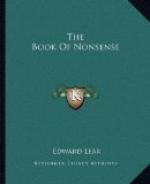INTRODUCTION.
Edward Lear, the artist, Author of “Journals of a Landscape Painter” in various out-of-the-way countries, and of the delightful “Books of Nonsense,” which have amused successive generations of children, died on Sunday, January 29, 1888, at San Remo, Italy, where he had lived for twenty years. Few names could evoke a wider expression of passing regret at their appearance in the obituary column; for until his health began to fail he was known to an immense and almost a cosmopolitan circle of acquaintance, and popular wherever he was known. Fewer still could call up in the minds of intimate friends a deeper and more enduring feeling of sorrow for personal loss, mingled with the pleasantest of memories; for it was impossible to know him thoroughly and not to love him. London, Rome, the Mediterranean countries generally, Ceylon and India, are still all dotted with survivors among his generation who will mourn for him affectionately, although his latter years were spent in comparatively close retirement. He was a man of striking nobility of nature, fearless, independent, energetic, given to forming for himself strong opinions, often hastily, sometimes bitterly; not always strong or sound in judgment, but always seeking after truth in every matter, and following it as he understood it in scorn of consequence; utterly unselfish, devoted to his friends, generous even to extravagance towards any one who had ever been connected with his fortunes or his travels; playful, light-hearted, witty, and humorous, but not without those occasional fits of black depression and nervous irritability to which such temperaments are liable.
Great and varied as the merits of his pictures are, Lear hardly succeeded in achieving any great popularity as a landscape-painter. His work was frequently done on private commission, and he rarely sent in pictures for the Academy or other exhibitions. His larger and more highly finished landscapes were unequal in technical perfection,—sometimes harsh or cold in color, or stiff in composition; sometimes full of imagination, at others literal and prosaic,—but always impressive reproductions of interesting or peculiar scenery. In later years he used in conversation to qualify himself as a “topographical artist;” and the definition was true, though not exhaustive. He had an intuitive and a perfectly trained eye for the character and beauty of distant mountain lines, the solemnity of rocky gorges, the majesty of a single mountain rising from a base of plain or sea; and he was equally exact in rendering the true forms of the middle distances and the specialties of foreground detail belonging to the various lands through which he had wandered as a sketcher. Some of his pictures show a mastery which has rarely been equalled over the difficulties of painting an immense plain as seen from a height, reaching straight away from the eye of the spectator until it is lost in a dim horizon. Sir Roderick Murchison used to say that he always understood the geological peculiarities of a country he had only studied in Lear’s sketches. The compliment was thoroughly justified; and it is not every landscape-painter to whom it could honestly be paid.




